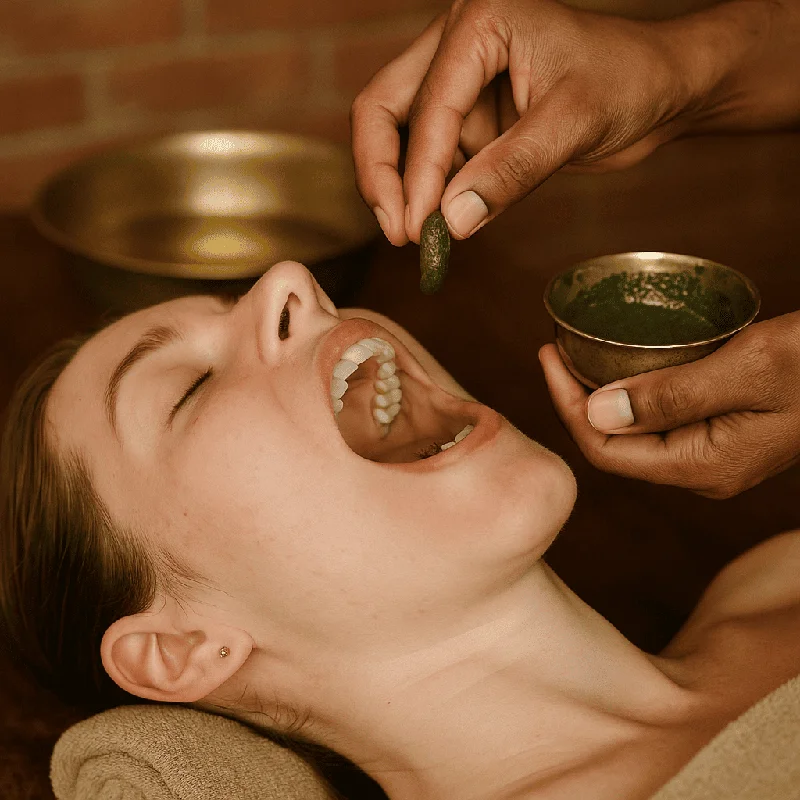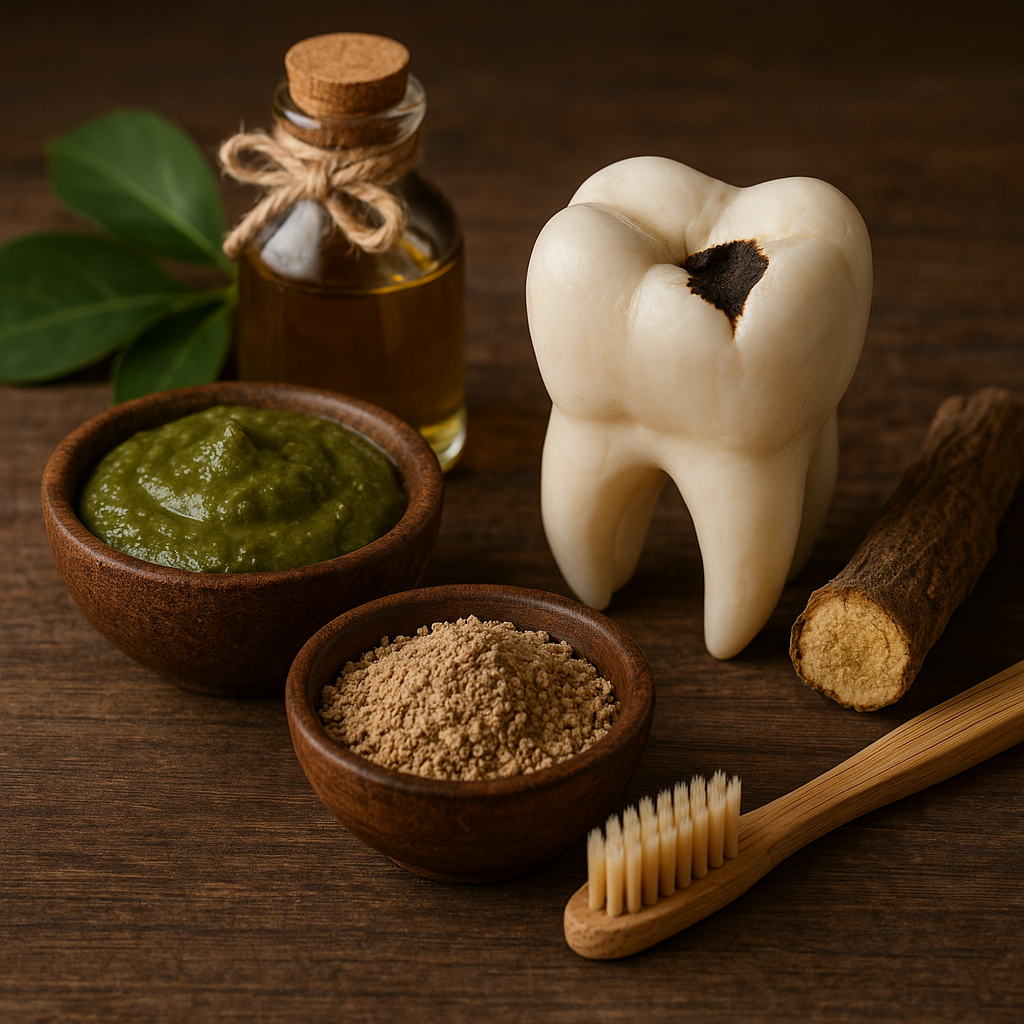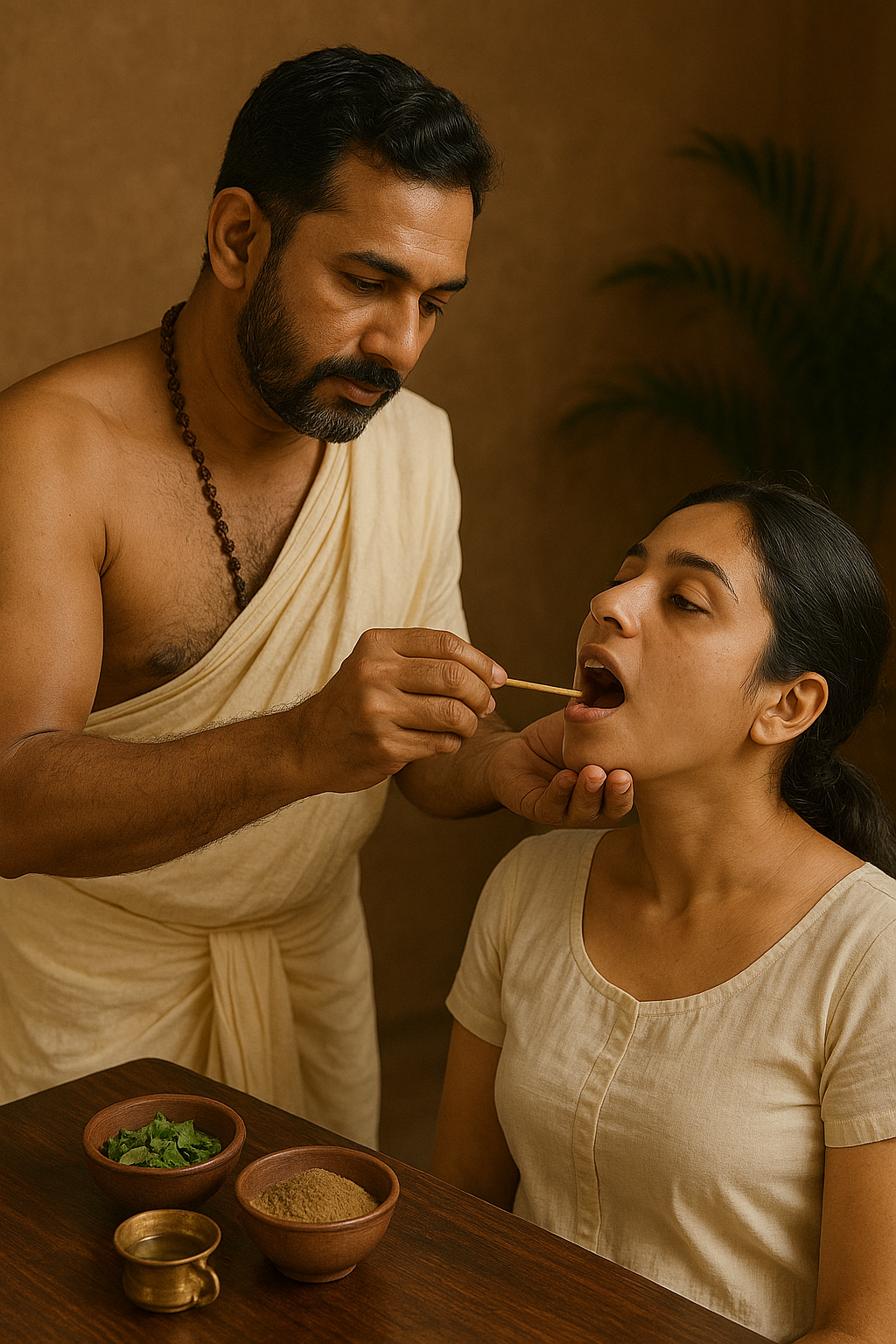Ask Ayurvedic doctor a question and get a consultation online on the problem of your concern in a free or paid mode. More than 2,000 experienced doctors work and wait for your questions on our site and help users to solve their health problems every day.
Shop Now in Our Store
Ayurvedic Treatment for Teeth Cavities: A Real, Root-Level Solution

Wait, Ayurvedic Treatment for Cavities? Yes — And It’s More Than Just Oil Pulling
Let’s get this out of the way first: when most people hear “Ayurveda” and “teeth,” they think of oil pulling and turmeric toothpaste. But there’s much more to it. Cavities, known as “Dantaharsha” or “Krimi” in Ayurvedic texts depending on the context, are not just random holes that appear in your teeth — they’re signals from your body. And Ayurveda, being the 5000-year-old science of life that it is, takes this very personally.
Dental caries (cavities) have become so common that most people shrug them off — until they land in the dentist’s chair needing a root canal. Globally, over 2.5 billion people suffer from untreated dental cavities. It’s the most prevalent chronic disease on Earth, and yet... we still act surprised every time our molars start aching.
Here’s where Ayurveda steps in — not as an alternative, but as a complement and sometimes even a preventive, root-cause-focused approach. While modern dentistry handles symptoms and structure, Ayurveda digs deeper — way deeper — into diet, digestion, doshas, lifestyle, and even emotional states that trigger oral degeneration.
In this article, we're not going to hand you shallow “natural hacks.” Instead, you'll get a full, lived-in picture of how Ayurveda sees cavities — what causes them, how they progress, and how you can halt or reverse that progression (yes, reversal is possible in early stages, especially when we’re not only talking physical treatment but systemic correction).
You’ll learn:
-
How Ayurvedic practitioners read your tongue, pulse, and diet to diagnose cavity risks.
-
The role of Kapha dosha, the sneaky enemy here.
-
What you’re probably doing daily that’s quietly eroding your enamel.
-
The herbs, routines, therapies, and weirdly effective (but totally safe) home remedies.
-
And whether you really need to give up your morning coffee (spoiler: maybe not completely).
Let’s dive in. You may never see your toothpaste the same way again.

Understanding Ayurvedic Treatment for Teeth Cavities: A Full Circle View
What Exactly Is a Tooth Cavity? (The Scientific Lowdown)
A cavity is a decaying process — the enamel breaks down, usually from bacterial acids. Think of it like rust for your teeth, only sneakier.
Here’s how it unfolds:
-
Stage 1: Bacteria from food debris (especially sugar and carbs) produce acids that erode enamel.
-
Stage 2: This creates tiny holes — demineralized spots.
-
Stage 3: If untreated, the damage reaches the dentin, the softer inner layer.
-
Stage 4: The pain begins — sensitivity to cold, sweet, even breathing in.
-
Stage 5: The infection hits the pulp, triggering inflammation and potentially leading to abscesses and systemic issues.
It’s not just about brushing. Poor gut health, nutrient deficiencies (like Vitamin D, K2, Magnesium), mouth breathing, and even stress all feed this fire.
Complications? Well, beyond pain, we’re talking infections that can impact the heart, kidneys, and brain. Yes, a cavity can be a systemic threat — not just a nuisance.
Ayurveda's View: The Dosha Dance Behind the Decay
In Ayurveda, cavities aren’t caused by bacteria alone. They’re a manifestation of internal imbalance — particularly of Kapha and Vata doshas, sometimes Pitta in chronic inflammation.
-
Kapha imbalance leads to stagnation and accumulation — plaque buildup, mucus-like coating on tongue, sluggish metabolism.
-
Vata imbalance creates dryness in the mouth, weakens bone tissue (asthi dhatu), and depletes ojas — your vitality juice.
-
Pitta excess triggers inflammation, gum sensitivity, and sometimes foul smell or ulcers.
Ayurveda doesn’t just stop at labeling. It explores “Nidana” (causes), “Purvarupa” (early signs), and “Samprapti” (pathogenesis). Everything from improper chewing to late-night eating, cold drinks, emotional suppression — they all play a role.
So, How Does Ayurveda Differ From Modern Dentistry?
Modern dentistry is reactive. Ayurveda is preventive and curative, and very much holistic.
For instance:
-
Dentists look for cavities with X-rays. Ayurveda feels them through pulse, checks for doshic imbalances, and assesses your entire digestion and nutrition.
-
Western solutions often involve drilling and filling. Ayurveda aims to stop the decay, strengthen the enamel, and correct lifestyle.
-
Ayurveda sees the mouth as part of the GI system. Tooth health is a direct expression of your Agni (digestive fire) and your Rasa Dhatu (first tissue level formed from digested food).
And fun fact? Ayurveda predicted the link between oral health and systemic disease long before scientific journals caught up.
Why Are We Getting So Many Cavities? (According to Ayurveda)
Main Ayurvedic Causes of Tooth Decay
In Ayurveda, no disease — including cavities — just happens. It unfolds from imbalances caused by wrong habits, often repeated over time.
-
Improper Diet (Ahara):
-
Excess sweet, sour, and acidic foods → weaken teeth structure.
-
Too much cold food or drinks → reduces digestive fire (Agni), weakens tissue formation.
-
Incompatible food combinations (like milk and fruit, or yogurt with fish — yes, people do that) → creates toxins or Ama, which eventually damages oral tissues.
-
-
Lifestyle (Vihara):
-
Sleeping right after meals, irregular eating, staying up late.
-
Sedentary lifestyle → Kapha aggravation → mucus, dampness → bacterial breeding grounds.
-
Mouth breathing at night (which many people don’t know they do) → dries up saliva, disturbing natural mouth flora.
-
-
Mental Stress (Manasika Nidana):
-
Suppressed anger or grief → vitiates Pitta or Vata, weakening bone metabolism.
-
Ever heard of someone who clenches their jaw when angry? Ayurveda considers that significant.
-
-
Low Ojas (Vitality):
-
Overworking, poor sleep, emotional burnout reduce Ojas — your body’s natural immunity and repair mechanism.
-
Common Triggers & Risk Factors in Ayurveda
-
Overuse of sour foods (pickles, tamarind, citrus): Pitta aggravation, enamel erosion.
-
Too much sugar: Obvious, but Ayurveda links it to both Kapha increase and Ama formation.
-
Cold water after meals: Stops digestion mid-process, causing incomplete absorption → poor tissue nourishment.
-
Skipping oiling routines (Gandusha/Kavala): This ancient oral care isn’t optional — it’s protective.
-
Brushing too hard or with wrong tools: Using chemical-heavy toothpaste or hard bristles destroys gums and agni in the mouth.
Why Our Modern Habits Are Basically a Cavity-Making Machine
-
Processed food: Strips nutrients and feeds harmful oral bacteria.
-
Constant snacking: No rest for digestive enzymes. Ayurveda promotes “between-meals fasting”.
-
Tooth-whitening obsession: Overuse of bleaches weakens enamel.
-
Ignoring oral care as part of the body: Your teeth aren’t just accessories; they reflect your inner health.
We’ve normalized poor oral health so much, we treat it like a rite of passage. Ayurveda says — it doesn’t have to be this way.
Spot the Signs Early – Ayurvedic Clues Your Teeth Need Help
Obvious Symptoms (But Sometimes Ignored Anyway)
Let’s start with the usual suspects:
-
Toothache, especially after eating sweet or cold foods.
-
Visible pits, holes, or dark spots on teeth.
-
Bad breath that doesn’t go away — not just a gum thing.
-
Sensitivity to air, touch, brushing.
-
Bleeding gums (if Pitta’s involved).
Ayurveda doesn’t wait for full-blown pain to act. You can catch signs much earlier.
Subtle or Overlooked Signs Ayurveda Warns About
-
Tingling in teeth while eating sour or cold food.
-
Dry mouth despite drinking water. Suggests Vata imbalance.
-
White coating on the tongue. That’s not just “morning breath” — it’s Ama.
-
Cracks in enamel or nails. Weak Asthi Dhatu.
-
Mild gum recession. Could signal deeper systemic dryness or tissue depletion.
These little clues often precede any clinical cavity.
When to See an Ayurvedic Practitioner — And When You Might Need a Dentist Instead
Seek Ayurvedic help when:
-
You’ve just started noticing sensitivity or discomfort.
-
You want to prevent cavities naturally.
-
You have recurring decay despite brushing/flossing.
-
You’re dealing with dryness or inflammation without visible holes.
But Ayurveda isn’t magical. You’ll still need a dentist when:
-
The cavity has hit the pulp.
-
There’s an abscess, swelling, or fever.
-
You’ve lost a significant part of the tooth.
In those cases, get the emergency care — then follow up with Ayurveda for regeneration and prevention.
So, How Do They Even Diagnose Cavities in Ayurveda?
Pulse, Tongue, Face — All Give Clues
-
Nadi Pariksha (Pulse Diagnosis):
A skilled Vaidya (Ayurvedic doctor) can detect imbalances by feeling your pulse — Vata, Pitta, and Kapha each have unique rhythms. -
Jihva Pariksha (Tongue Reading):
-
White coating: Kapha and Ama buildup.
-
Redness: Pitta aggravation.
-
Cracks: Vata dryness.
-
Even teeth impressions along the edge can indicate poor absorption — a root cause.
-
-
Drik (Eyes), Sparsha (Skin), Akruti (Body structure):
All reflect doshic imbalance — even something like dark circles or brittle nails.
Figuring Out Dosha-Specific Decay
-
Vata-Type Cavities: Dry mouth, brittle teeth, sharp intermittent pain, aggravated by cold wind.
-
Pitta-Type: Red gums, inflammation, bleeding, burning sensation, especially after spicy food.
-
Kapha-Type: Heavy coating, dull pain, plaque, frequent saliva, tendency to rot slowly.
The treatment approach depends on the dominant dosha and the person’s Prakriti (constitution). There’s no one-size-fits-all — which is why general advice sometimes fails.

Real Ayurvedic Treatments That Go Beyond Grandma’s Remedies
The Heavy Hitters: Ayurvedic Herbs & Formulas
Here’s what actually works — not just feel-good suggestions:
-
Triphala Churna: Antibacterial, anti-inflammatory. Rinse mouth or take internally for detox.
-
Neem (Azadirachta indica): The OG antibacterial herb. Powder form or twigs as toothbrushes (Datun).
-
Clove (Lavanga): Topical oil reduces pain and fights infection.
-
Bakula (Mimusops elengi): Strengthens gums, used in medicated powders.
-
Dashana Samskara Churna: A classical tooth powder blend. Use for brushing or massaging.
Dosage Example:
-
Triphala: 1 tsp at night with warm water internally; or decoction for gargling.
-
Neem powder: mix with sesame oil and massage gums 2x/day.
-
Clove oil: dab a drop directly on the cavity or sensitive spot.
Always consult an Ayurvedic doctor — herbs can interact with medications or conditions.
Ayurvedic Therapies & Panchakarma Treatments
-
Gandusha (Oil Holding): Hold warm sesame or coconut oil in mouth for 10-15 min. Do NOT gargle or swallow.
-
Kavala (Oil Swishing): Similar to oil pulling, but done more actively and briefly.
-
Nasya Therapy: Helps reduce upper body Vata — indirectly supports oral health.
-
Mridu Virechana (Mild purgation): Especially if Pitta is high, helps clear inflammation.
These aren’t “spa” treatments. They’re targeted detox and nourishment — especially Panchakarma, which cleanses at the tissue level.
Effective Home Remedies You Can Actually Do
-
Chewing guava leaves (antibacterial, anti-inflammatory).
-
Salt + mustard oil + turmeric paste — massage on gums for 2 minutes daily.
-
A pinch of black sesame seeds after meals — rich in calcium and healthy oils.
Bonus: stop rinsing your mouth immediately after eating — it disturbs digestion and weakens Agni.
What to Eat (and NOT Eat) If You Have Cavities, According to Ayurveda
Eat This: Foods That Strengthen Teeth, Enamel, and Tissues
Ayurveda’s take on food is deep. It’s not just about nutrition — it’s about digestion, assimilation, and transformation into dhatus (body tissues). So, if you’re dealing with cavities, here’s what your plate should look like:
✅ Best Foods
-
Warm, soupy, lightly spiced meals: Think khichdi with ghee, moong dal soups, soft vegetables.
-
Sesame seeds: Natural calcium bomb. Add roasted black sesame to porridge or rice.
-
Ghee: Lubricates tissues, strengthens ojas. Add 1 tsp to meals.
-
Milk (boiled with turmeric or cardamom): Builds Asthi dhatu (bone tissue). Boil well to reduce mucus.
-
Cooked leafy greens: Spinach, moringa, fenugreek — rich in minerals.
-
Dates and figs (in moderation): Strengthen bones but should be soaked and cooked.
-
Spices like turmeric, cinnamon, cardamom: Anti-inflammatory and digestion boosting.
-
Rock salt or sendha namak: Better than processed salt; supports mineral balance.
🍽️ Cooking Tips
-
Always eat warm food. Cold foods douse Agni.
-
Use ghee, not refined oils.
-
Favor simple meals with few ingredients — easy on digestion.
Avoid These: Foods That Trigger or Worsen Cavities
❌ Problem Foods
-
Refined sugar: Feeds bacteria, spikes Kapha, causes Ama.
-
Cold drinks: Cold dulls Agni, damages enamel.
-
Fermented or sour foods in excess: Like vinegar, pickles — can aggravate Pitta and demineralize teeth.
-
Nightshades (tomatoes, brinjal): Increase acidity in some people.
-
Hard, dry snacks: Chips, brittle — weaken enamel, increase Vata.
-
Carbonated drinks: Highly erosive.
-
Overeating dairy: Especially cheese and curd at night — clog channels, increase Kapha.
⚠️ Food Combining Warnings
-
No milk + sour fruits.
-
No curd at night.
-
No fruit + grains (e.g., fruit smoothies with oats).
Eat with mindfulness, chew slowly, and don’t talk while eating. Ayurveda says digestion begins in the mouth — literally.
Lifestyle Fixes That Really Matter
-
Wake up before sunrise – Calms Kapha and Vata, syncs with circadian rhythm.
-
Scrape your tongue daily – Removes Ama.
-
Use herbal tooth powders – Like Dashana Samskara. No fluoride chemicals.
-
Oil pulling every morning – Use sesame oil or coconut oil.
-
Don’t eat late at night – Digestive fire is low, food ferments.
-
Midday as main meal – That’s when Agni is strongest.
-
Stay hydrated – but not during meals – Sip warm water between meals only.
-
Practice Nasya (nasal oiling) – Helps regulate Prana and reduces oral dryness.
Herbs, Medicines, and Warnings
Here’s a focused list, but do check with a practitioner first:
📜 Herbs & Remedies
-
Arimedadi Taila: Medicated oil for gargling. Strengthens gums, reduces decay.
-
Triphala Churna: Detox, tissue rebuild. 1 tsp at night with warm water.
-
Dashana Samskara Churna: Herbal tooth powder.
-
Gandusha with sesame oil: Daily or every other day.
-
Clove oil: Spot-application for pain.
⚠️ Warnings
-
Pregnancy: Avoid detox herbs like Triphala unless guided.
-
Allergies: Neem, clove, or sesame sensitivity? Use alternatives.
-
Chronic diseases: Always consult an Ayurvedic doctor for tailored dosages.
Real People, Real Results – Ayurvedic Wins Over Cavities
I remember a woman in her late 30s — let’s call her Anita. Constant cavities. Had three fillings already. But she hated going to the dentist.
She turned to Ayurveda. Within 3 months of using Triphala, switching to Dashana Samskara Churna, and doing oil pulling daily, her tooth sensitivity disappeared. Her dentist noted "no new cavities" at her 6-month checkup. Her biggest change? Eating warm meals on time. No more midnight snacking.
Stories like Anita’s are common — but only when people stick to the regimen. Ayurveda is slow — but real. Think compost, not chemical fertilizer.

What the Science Actually Says About Ayurveda for Cavities
Let’s be honest — Ayurveda isn’t always embraced by mainstream science. But things are changing.
📊 What Studies Show
-
A 2014 study in the Journal of Clinical and Diagnostic Research found oil pulling with sesame oil reduced Streptococcus mutans — the main cavity-causing bacteria — as effectively as chlorhexidine.
-
Triphala mouthwash was found in multiple trials to reduce plaque and gingivitis significantly.
-
Herbal powders like Dashana Samskara showed antimicrobial effects in vitro — no side effects like chemical rinses.
🔬 Ayurveda vs Conventional
-
Modern: Drills and fills. Fast, effective, localized.
-
Ayurveda: Slower, holistic, corrects root causes.
It’s not either-or. Many integrative dentists now recommend Ayurvedic support alongside clinical treatments.
Busting Common Myths About Ayurveda and Cavities
-
“Ayurveda is too slow to work.”
-
Not true. Early cavities can show improvement in 2–3 weeks.
-
-
“You can’t reverse cavities naturally.”
-
Depends on stage. Initial demineralization? Yes. Deep decay? No.
-
-
“Brushing is enough.”
-
Not if your digestion is off or doshas are wild.
-
-
“All Ayurvedic products are safe.”
-
Only if sourced properly. Lots of fake powders out there.
-
-
“Oil pulling replaces brushing.”
-
Nope. It’s complementary, not a replacement.
-
Final Thoughts – Ayurveda Isn’t Just About Teeth, It’s About You
If you’ve made it this far — first, hats off to your curiosity and commitment.
Ayurvedic treatment for teeth cavities is about more than dental hygiene. It’s about rebalancing your inner ecology so that decay doesn’t even get a chance to begin. Yes, brush your teeth. Yes, see your dentist. But also — check your digestion, sleep, emotional health, and daily rhythm.
Teeth are the hardest tissue in the body. But they’re also deeply connected to your vitality.
Ready to take the first step? Don’t self-prescribe. Get a personalized consultation at Ask-Ayurveda.com — your teeth will thank you.
FAQ: Ayurvedic Treatment for Teeth Cavities
1. Can Ayurveda really heal cavities?
Yes — in early stages (enamel demineralization), Ayurveda can halt or reverse the decay using herbs, diet, and oil therapies. Advanced cases still need dental work.
2. How long does it take to see results?
You might notice reduced pain or sensitivity within 2–4 weeks. Structural improvement can take 3–6 months, depending on your adherence.
3. Is oil pulling safe for kids?
Yes, but use mild oils like coconut, and limit to 5–10 minutes. Always supervise young children.
4. Can I use both Ayurvedic and regular toothpaste?
Yes. Use Ayurvedic powders or pastes in the morning, and your usual fluoride paste at night if needed.
5. Are there side effects to Ayurvedic dental herbs?
Rarely — but always check for allergies. Neem and clove may cause irritation in sensitive mouths. Use cautiously during pregnancy.
References
-
AYUSH Ministry - Government of India -
National Institutes of Health - NCCIH -
World Health Organization (WHO) -
PubMed

